Support:
+49 (0) 89 24418362

Grease the silicone mold - is it really necessary?
Why do baking pans need to be greased?
To ensure that a cake can be removed cleanly and easily from the baking pan, the pan should always be greased and floured before the batter is placed in it. This is particularly important when using an elaborate cake tin such as a Bundt cake or when baking a tall, multi-layered cake. Why this is so depends on the ingredients, with butter and eggs being the most common. Because the less butter and the more eggs you use, the more likely it is that the dough will stick to the mold. For cake recipes with a rather dough-like consistency, greasing and flouring the mold is essential. If the recipe for the cake recommends this, the advice should definitely be followed. The flour acts as a barrier between fat and dough. Without the flour layer, the fat would soak into the dough during baking and ultimately cause sticking. An exception may be sheet cakes that are to be served piecemeal directly from the sheet. But even then it makes more sense to grease and flour the mold beforehand. A thin layer of fat and flour makes the slices of cake easier to cut. To prepare the form, it is first brushed with a thin layer of fat using a pastry brush and then dusted with flour. It is important to ensure that all areas are carefully covered. It is best to grease and flour the cake tin over the sink. In this way, the excess flour can be washed away and the kitchen floor is spared.What alternative to butter is there for greasing?
According to a rule, if a cake is made with butter, the cake tin should also be greased with it. Plus, butter is tastier than cooking spray or vegetable oils because the water in the butter evaporates in the oven, creating tiny plumes of steam that help create a light, tender cake. But butter isn't necessarily the best choice. When it comes to greasing baking pans, vegetable oils and cooking spray are a better choice. While they don't add any extra buttery flavor to the cake, they do a better job of preventing sticking. Vegetable oils and cooking sprays are 100% fat, so they don't have the same stickiness as butter, which contains water. Vegetable oils for greasing cake tins should be tasteless, such as sunflower oil or canola oil. Olive oil is more suitable for bread or rolls. In addition, margarine or lard can also be used. In addition to flour, sugar, ground nuts and almonds are also suitable for dusting the baking tins, while cocoa powder goes well with brownies. The best alternative is to use parchment paper, with no greases required. Laying a sheet of parchment paper in the bottom of a cake tin will prevent the dough from sticking. The paper is easy to peel off after baking and can be cut to fit the molds. This method is especially useful for baking cookies on baking sheets or pound cakes in springform pans. To line the sides of the mold, they are rubbed with a little fat so that the parchment paper sticks.What is baking spray and how safe is it?
Baking spray is one of the best-working methods for perfectly triggering baked goods. Spray fat from a can is called baking release spray, which is not only suitable for baking, but also for grilling and roasting. It differs from conventional frying fat in that it comes from a spray can. This makes it much more practical to use and allows for more accurate dosing of the fat. As a rule, baking sprays are based on vegetable fats such as rapeseed oil and olive oil. Cooking spray is not only used for convenience, but also to reduce the use of fats. Still, baking sprays aren't completely calorie-free. Before buying a baking spray, the ingredients should be determined. Most manufacturers use only vegetable oils, while there are also some brands that contain a mix of oils and artificial flavors. Baking spray is more expensive than bottled oil. When using it, it should be noted that the spray must never be sprayed into an open flame.How is DIY baking spray prepared?
Homemade baking spray is more eco-friendly, cheaper, and can be made from a variety of oils. It can be used in exactly the same way as store-bought cooking spray, except that it needs to be shaken vigorously a few times before use. Ingredients:- 1/2 cup canola oil or sunflower oil
- 1/2 cup coconut oil
- 1/2 cup flour (wheat or spelled)
- Put all ingredients in a mixing bowl.
- Beat with an electric mixer until the mixture has slightly increased in volume and becomes creamy.
- Pour into an airtight container with a lid (like a mason jar). The release agent can be stored in the kitchen cupboard. In the warmer months, it should be kept in the fridge.
- If the mixture separates, simply stir it to mix the ingredients back together.
- Use a pastry brush to brush the baking pan with the homemade release agent. Remember that a small amount is enough.
What are the advantages of silicone molds?
Making baked goods with silicone molds is very easy. They come in many shapes and sizes, making the work much more interesting and fun. Although they haven't been around for that long, there are already many creative ways to use them. The biggest advantage of the baking molds is that they are made of a non-stick silicone material. As a result, they do not have to be greased to release the baked goods from the molds. If you want to be absolutely sure that nothing sticks, you can rinse the molds with cold water before baking and fill in the dough immediately afterwards. Silicone molds can be used, rinsed and reused as often as you like. They are extremely flexible and will return to their original shape if bent. In addition, compared to molds made of glass and metal, they are indestructible and can be stored in a confined space to save resources. Silicone molds are temperature resistant within a range of minus 60 to plus 230 degrees Celsius, so they can be taken out of the oven or microwave and immediately placed in the fridge or freezer. Silicone bakeware comes in a wide range of bright colors and many interesting shapes, faithfully reproducing all the details of the baking process. As a rule, silicone baking molds are tested in compliance with food regulations. They undergo thermal processes lasting six to seven hours to eliminate potentially toxic residues, making them harmless to health. Last but not least, they are available at affordable prices.What products does Wisefood offer?
Wisefood has a wide range of silicone baking molds in different sizes, colors and shapes for a wide variety of occasions. These include colorful shapes for children's birthday parties with cute animal motifs or educational shapes with letters and numbers, as well as special shapes for the Christmas season, Valentine's Day or bachelor parties, family celebrations and much more. All molds are made of extremely flexible silicone material and are tasteless, food-safe and suitable for the dishwasher and for freezing. They are ideal for baking, for desserts such as jello and ice cream, or for making chocolates. If the molds have become weathered or damaged over time, they can simply be disposed of with the residual waste.How are silicone molds maintained?
No harsh detergents or rinse aids for dishwashers may be used to clean the moulds. Rinse aid can form a white film on the surface of the mold which can change the taste. This does not affect the performance and safety of the mold. To remove the coating, the molds can be boiled in hot water. At best, the molds should be rinsed out with water immediately after baking and later cleaned by hand with a mild detergent. To prevent silicone bakeware from drying out and falling apart, store them away from UV light and extreme heat. They are best stored in a box in the kitchen cupboard, with some cardboard placed between each layer. Muffin tins can be safely stacked on top of each other by lining them with special muffin paper liners. In order to maintain the flexibility and service life of rarely used silicone molds, they should be treated with release agents from time to time. Sources: https://www.gutekueche.at/backformen-correctly-einfetten-artikel-2360 https://blog.meincupcake.de/backform-ohne-butter-einfetten-geh-das-wir-showen-wie/ https:/ /www.smarticular.net/backtrennmittel-selber-machen-backtrennspray-alternative/ https://www.lecker.de/backtrennspray-83204.html-
Product title
Original priceOriginal price €19,99€19,99€16,80Current price €19,99 -
Product title
Original priceOriginal price €19,99€19,99€16,80Current price €19,99 -
Product title
Original priceOriginal price €19,99€19,99€16,80Current price €19,99 -
Product title
Original priceOriginal price €19,99€19,99€16,80Current price €19,99 -
Product title
Original priceOriginal price €19,99€19,99€16,80Current price €19,99







